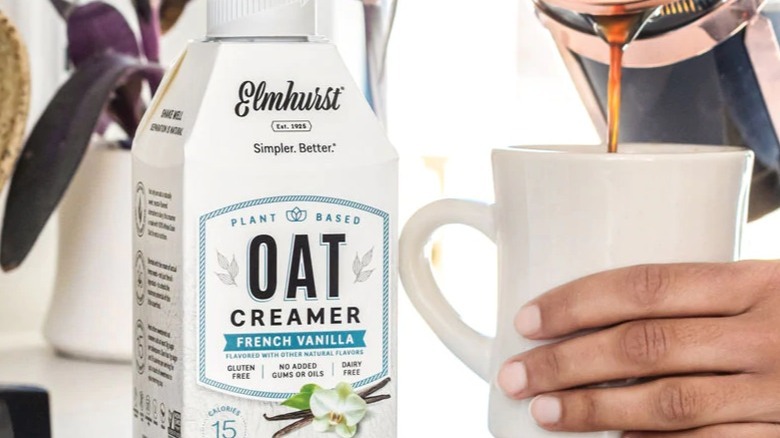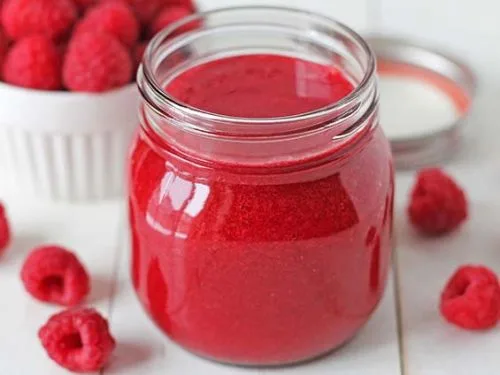.jpg)
Grass-fed milk, nondairy creamer, flavored syrups — ways to liven up your cup proliferate, but they're not all equally nutritious. Here’s what to know about commercial creamers, plus recipes for creating your own.
There was a time when coffee was straightforward. The only ingredients to a cup of coffee were milk and sugar. Today, as you stand in front of the supermarket shelves sizing up the options, you couldn't be faulted for enduring a bout of decision fatigue. There are powders, mixers, all types of nondairy options, and flavors that run the spectrum from classic vanilla and hazelnut to Mean Girls Pink Frosting.
So, are any of these options truly healthier for you than cow’s milk? Even oat milk, which had a long tenure as a health food, recently came under fire, with social media posts alleging it will increase your blood sugar. Flavored creamers can have tons of additional sweeteners, and then there are the emulsifiers, stabilizers, and preservatives that keep these products fresh and uncurdled in steaming coffee.
With so many coffee add-ins to choose from, it can be challenging to figure out which is the healthiest coffee creamer. Here’s a closer look at the options, plus two simple recipes for making your own coffee creamer and chilled froth without all the garbage.
Different Kinds of Coffee Creamers
Coffee creamers split down into four primary categories:
-
Basic dairy — milk, cream, and half-and-half
-
Basic nondairy — unadulterated almond, oat, soy, and coconut milk
-
Powders — nonperishable products, simple or flavored
-
Liquids — coffee-specific flavored products produced from either dairy or nondairy ingredients
In general, the simpler the product, the better, says Grace Derocha, a registered dietitian-nutritionist based in Detroit. “Basic dairy and nondairy options are best, meaning minimal ingredients and no added or very little added sugar,” she says. “Reading the ingredient list is very helpful in this process.”
When Is Coffee Creamer Bad for You?

“Using your favorite coffee creamer in moderation is nothing to worry about,” says Derocha. The problem is, many people don’t. She sees a lot of what she terms “coffee milkshakes” that are more creamer than coffee. Even if you use what you believe is a reasonable quantity of creamer, odds are it’s more than the typical serving measure of 1 tablespoon. Although minor, that can add up when you're consuming multiple containers every day. Nutritional values differ from brand to brand, but most have around 20 calories and at least 1 gram (g) of sugar per serving, per the U.S. Department of Agriculture (USDA).
Here are some of the constituents in coffee creamer you may want to be aware of, particularly if you tend to overpour.
Sugar and Other Sweeteners
You already know that too much sugar isn’t healthful. A diet high in refined and added carbohydrates, like the kind you find in many coffee creamers, has been found to contribute to chronic diseases including obesity, diabetes, and cardiovascular diseases, and to negatively impact cognition and mood, according to one review. Unfortunately, sugar is the second constituent in some of the most popular coffee creamers out there, including International Delight’s Caramel Macchiato flavor and Dunkin’s Extra Extra Creamer. Corn syrup solids (another way to state sugar) are also frequently on the constituents list.
Sugar substitutes may be no better. The World Health Organization issued an official guideline recommending against them, citing a lack of evidence supporting their use for weight control or reduced risk of chronic diseases.
As for the claims about oat milk increasing blood sugar, Derocha says it’s not likely to be a problem as long as the oat milk doesn’t contain added carbohydrates. All milk and milk substitutes have natural carbohydrates — lactose in cow’s milk, maltose in oat milk. And in a vacuum, these could theoretically elevate blood sugar. But without added carbohydrates driving up the total amount of sugar, those natural sugars are very unlikely to increase your blood sugar, particularly if the creamer contains fat or protein, both of which help prevent blood sugar surges. “What a person eats with their coffee will also impact whether blood sugar is elevated or not,” says Derocha. An oat milk latte with a cinnamon bun will increase your blood sugar, while a cappuccino paired with an omelet won’t.
A healthy person choosing unsweetened oat milk as coffee creamer most likely will not experience any unusual blood sugar activity.
Hydrogenated Vegetable Oil

You’ll see hydrogenated vegetable oil at the beginning of the ingredient list for many powdered creamers, such as in Coffee-mate's powdered creamer. Hydrogenated vegetable oil is used in powdered coffee creamer as a preservative and thickener. It extends the shelf life of the creamer and gives it a velvety texture. It’s terrible, but not as dreadful as you might expect. This constituent is often confounded with partially hydrogenated vegetable oil. Partially hydrogenated oils are trans fats, which were prohibited by the U.S. Food and Drug Administration (FDA) in 2015.[4] Hydrogenated vegetable oil, a primary constituent in powdered coffee creamers, does not contain trans fat.[5] That doesn’t make it healthful — it’s saturated fat, which increases your risk of cardiac disease.
So why does the label of coffee creamer state 0 g as the quantity of saturated fat? By law, the FDA says food manufacturers only have to identify an ingredient if there are 0.5 g or more per serving.
If there are fewer than 0.5 g of saturated fat in a serving, the label can legally assert “0 grams saturated fat.” A serving of powdered coffee creamer is technically only 2 g. So powdered creamer could be up to 25 percent saturated fat without having to include a number of grams of saturated fat on the nutrition label.
“It is so important to be aware of serving sizes, because of the different rules regarding what must be listed on the nutrition label,” says Derocha. “Be diligent by reading the nutrition facts carefully. Knowledge is power.”
Dipotassium Phosphate
Dipotassium phosphate is an additive found in many processed foods, including dairy products, and while the FDA has accorded it “generally recognized as safe” (GRAS) status, there is some concern about phosphate additives in general. Research has found they are assimilated at a much higher rate than naturally occurring phosphorus, and that fact, combined with their prevalence in processed foods, means many Americans could be overconsuming them.[7] High levels of phosphates in the blood have been linked to kidney problems, as well as increased risk of mortality and cardiovascular disease.[8] While research has only been observational and more rigorous studies need to be done, it’s not a terrible idea to limit phosphate additives in your diet.
Carrageenan
This ubiquitous culinary additive is derived from red algae. A USDA report that summarized existing research suggested that food-grade carrageenan does not pose substantial health hazards at dietary levels.[9] But some research suggests that carrageenan can negatively impact gastrointestinal health, causing intestinal inflammation.[10] One assessment recommended “personalized guidance on carrageenan intake based on individuals’ health status.”[11] Translation: Notice how products with carrageenan effect how you feel.
Gellan and Other Gums
Gellan gum is a plant-based alternative to gelatin that is used as a stabilizer and thickener. Research has found that gellan and other gums are safe, even when ingested in much larger quantities than you’d get in a few servings of coffee creamer.[12]
Are There Any Benefits to Coffee Creamer?

As long as you’re not lactose intolerant, any minimally processed, unadulterated dairy product is a perfectly healthful option. “It adds some calcium and protein to your coffee,” says Derocha. She’s also in favor of nondairy milks without added carbohydrates and with minimal ingredient lists.
Some coffee creamers claim functional constituents, including collagen and MCT oil. It’s possible these ingredients could deliver some benefits. One systematic review and meta-analysis found an association between MCT and lower calorie intake throughout the day.[13] “MCT oil may help with satiety because fat takes longer to digest than carbohydrates, therefore prolonging hunger cues, which in turn may lower one’s calorie intake throughout the day,” says Derocha.
As for collagen, one review suggests it might delay skin degeneration.[14] Another study showed that collagen supplements reduced joint pain by 43 percent and enhanced mobility by 39 percent.[15] But whether the amount of collagen added to a coffee creamer would be enough to have any effect is doubtful.
What About Cold Foam?
If you’ve ever seen an eye-catching chilled coffee drink crowned with a frothy white cloud on social media, you’re familiar with cool foam. Widely popularized by Starbucks when the company introduced it, in 2018, cold froth is now everywhere: coffee establishments, home kitchens — Reddi-Wip even produces a version in a can.
Cold froth, at its simplest, is just milk that’s been made foamy by forcing air into the liquid. You can do this with a portable electric milk frother, French press, or even by stirring milk vigorously in a container. It’s like the more traditional cappuccino foam, which is frothed with steam to make it heated. With cold foam, just air (no heat) is used to make it closer in temperature to chilled or chilly beverages.
Cold foam will be precisely as healthful as the ingredients used to create it, according to Derocha. Start with low-fat milk, and you’ve got a nutritious creamer. Start with a sugar-filled packaged creamer, and it’s not so wonderful. Your best choice is to use an affordable, wholesome, homemade cold foam.
.





.webp)

